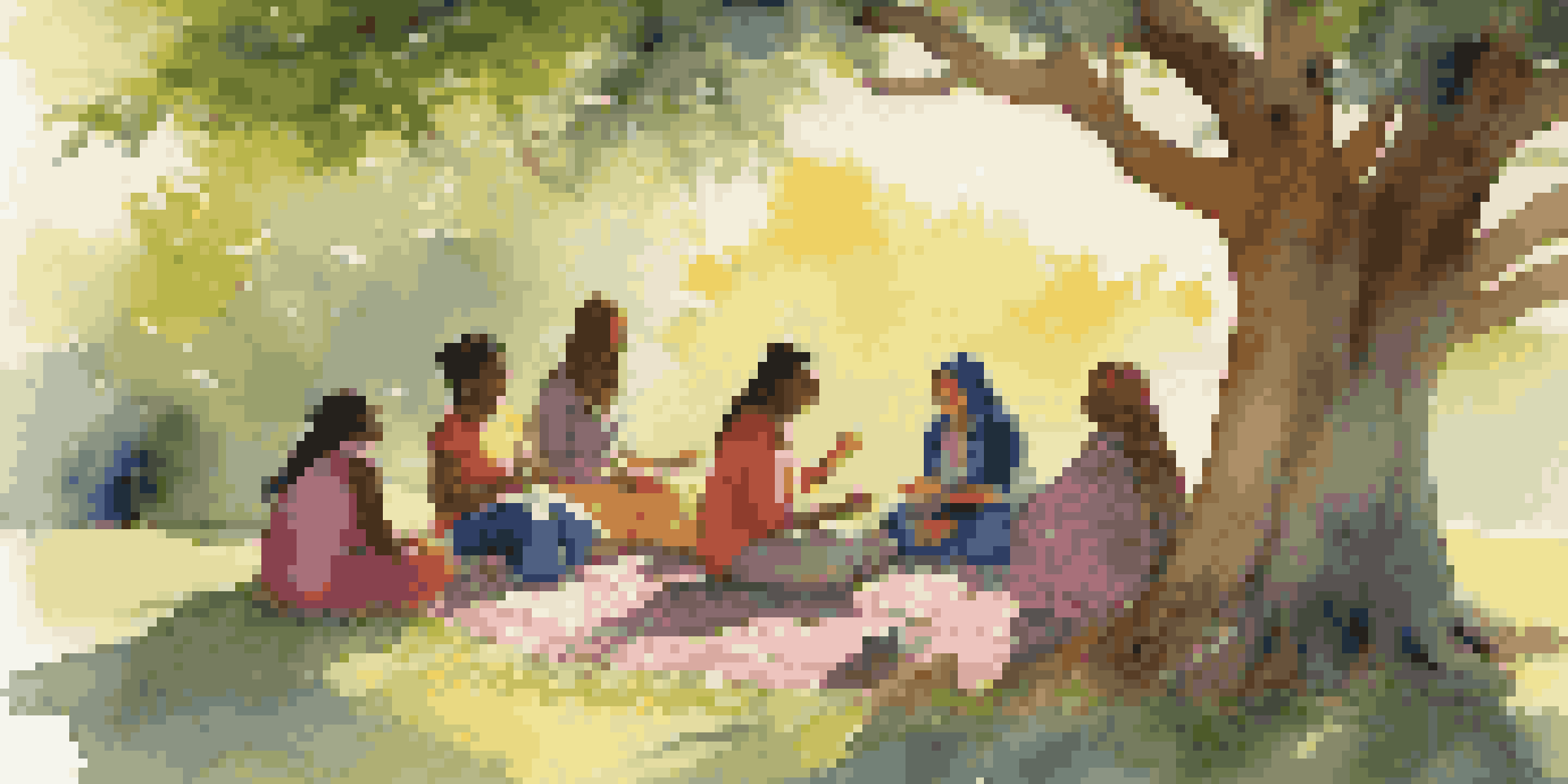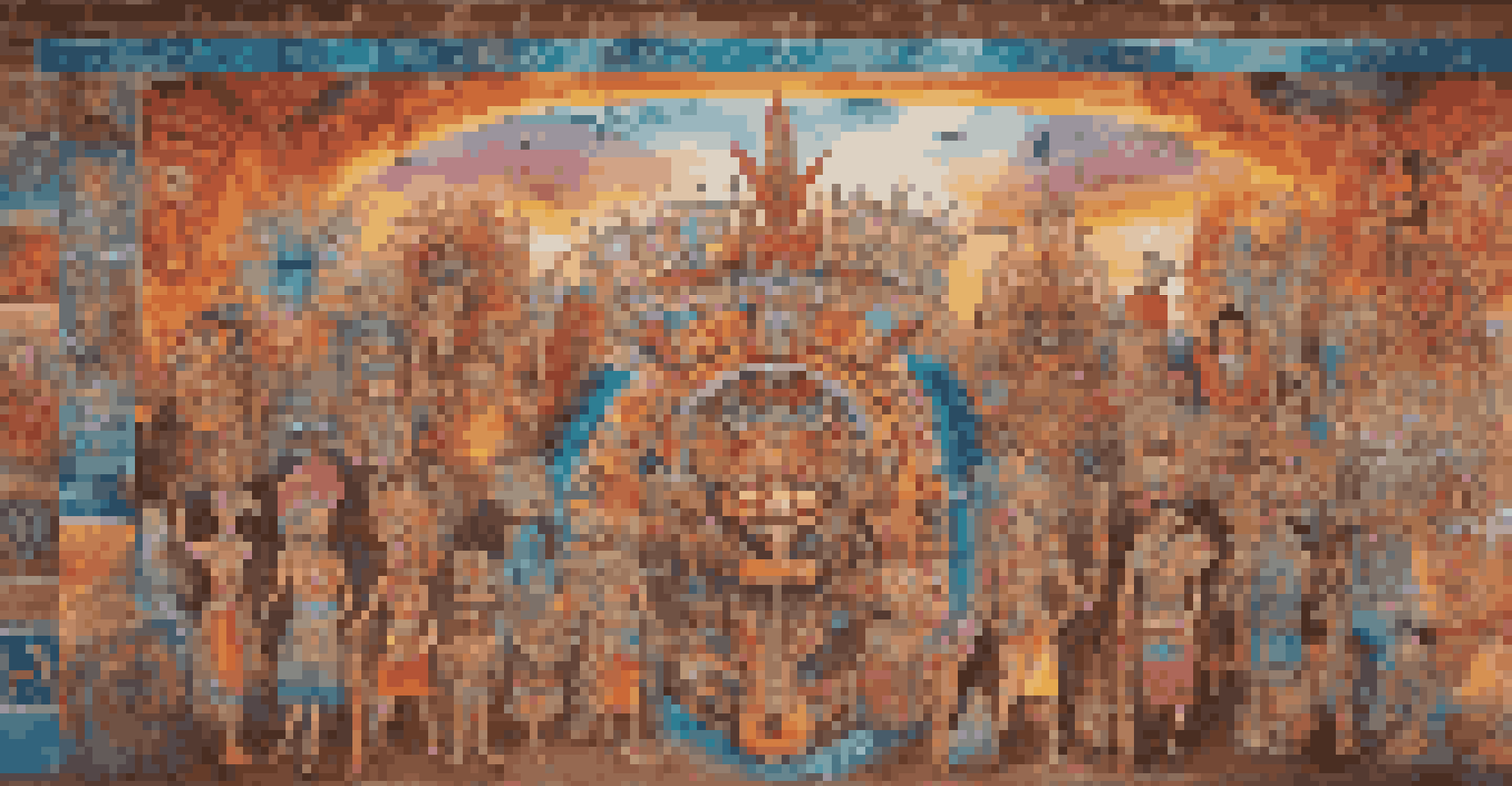The Importance of Oral Traditions in Cultural Art Forms

Understanding Oral Traditions and Their Significance
Oral traditions encompass the stories, songs, and rituals passed down through generations. These forms of expression are not just entertainment; they are vital tools for preserving culture and identity. Think of them as the glue that bonds communities together, allowing individuals to connect with their roots and shared histories.
Stories are the common ground of humanity. They are the basis of our culture and the key to our survival.
From Indigenous storytelling to African griots, oral traditions serve various purposes, such as education, entertainment, and social cohesion. They often encapsulate moral lessons and cultural values, making them essential for community identity. Without these narratives, vital aspects of culture might fade away, leaving future generations disconnected from their heritage.
In an age dominated by digital media, the importance of oral traditions remains as relevant as ever. They remind us that culture is not static but rather a living, breathing entity shaped by the voices of the past. Embracing these traditions fosters a sense of belonging that transcends time and place.
The Role of Oral Traditions in Preserving History
Oral traditions serve as living archives of history, capturing significant events and societal changes. Unlike written records, which can be lost or altered, these oral narratives are often retold with personal touches, making them dynamic and relatable. Consider how stories about historical figures or key events can vary from one storyteller to another, each adding their unique perspective.

Take the example of the Native American oral tradition, where stories of creation and ancestral heroes are passed down. These narratives not only preserve the history of the people but also provide insights into their worldview and values. Through these stories, listeners gain a sense of identity and understanding of their place within a larger historical context.
Oral Traditions Preserve Culture
Oral traditions serve as vital tools for preserving cultural identity and community bonds through storytelling and shared experiences.
In many cultures, oral traditions are complemented by rituals and ceremonies that further reinforce historical narratives. These practices create a shared experience that binds communities together, ensuring that the lessons of the past remain alive in the present. This interconnectedness between history and oral storytelling highlights the critical role these traditions play in shaping cultural consciousness.
The Artistic Expression Found in Oral Traditions
Oral traditions are not just historical accounts; they are also forms of artistic expression that showcase creativity and imagination. From poetry to music and performance, these traditions allow individuals to convey complex emotions and ideas in captivating ways. Think of storytelling as a canvas where tradition and creativity merge to create something beautiful.
A people without the knowledge of their past history, origin and culture is like a tree without roots.
For instance, the call-and-response style of African American spirituals illustrates how oral traditions can blend music and narrative. This interactive form of storytelling engages the audience, making them active participants in the experience. Such artistic expressions enrich cultural landscapes and invite others to share in the narrative journey.
Moreover, the oral tradition often adapts to contemporary themes, ensuring its relevance in modern society. By incorporating current issues into traditional tales, storytellers breathe new life into age-old narratives. This ability to evolve while retaining core elements speaks to the resilience and enduring power of oral traditions in cultural art forms.
Oral Traditions as Tools for Education and Morality
One of the primary functions of oral traditions is education, particularly in teaching moral lessons and social norms. Through engaging stories, listeners learn about the values that are important within their culture, such as honesty, bravery, and respect. These narratives serve as both instruction and entertainment, making learning an enjoyable experience.
For example, fables like Aesop's Tales are known worldwide for their simple yet profound moral lessons. The story of the tortoise and the hare teaches us about perseverance and humility, principles that resonate across cultures. Such narratives often transcend age, imparting wisdom to both young and old, which is why they endure through generations.
Education Through Storytelling
These narratives not only entertain but also impart moral lessons and social norms, making learning enjoyable and relevant across generations.
In many communities, elders take on the role of storytellers, imparting knowledge and values to the younger members. This intergenerational exchange not only preserves cultural heritage but also strengthens community bonds. In essence, oral traditions function as a moral compass, guiding individuals in their personal and communal lives.
The Connection Between Oral Traditions and Identity
Oral traditions play a pivotal role in shaping individual and collective identity within cultural contexts. They offer a sense of belonging, allowing people to identify with their heritage and the stories that define it. This connection to one’s roots fosters pride and reinforces the idea that everyone has a role in the larger narrative.
Consider the power of a family story that has been told for generations. It not only connects individuals to their ancestors but also instills a sense of responsibility to carry forward that legacy. When people share these stories, they reinforce their cultural identity, creating a tapestry of experiences that enrich the community.
Furthermore, in an increasingly globalized world, oral traditions serve as a reminder of unique cultural identities. They highlight the diversity of human experiences and encourage respect for different backgrounds. By valuing these traditions, we celebrate the rich mosaic of cultures that make up our global society.
Challenges Facing Oral Traditions Today
Despite their significance, oral traditions face numerous challenges in today's fast-paced world. The rise of digital technology has shifted how stories are shared, often sidelining traditional storytelling practices. While technology offers new platforms for sharing narratives, it can also dilute the essence of these age-old traditions.
Moreover, globalization can pose a threat to local cultures, leading to the loss of unique oral traditions as communities adapt to mainstream narratives. As younger generations increasingly turn to digital media for entertainment, the rich tapestry of oral storytelling risks being overshadowed. This shift raises concerns about the survival of these cultural legacies.
Challenges and Revival Efforts
Despite facing challenges from digital technology and globalization, efforts are underway to revitalize oral traditions and engage younger audiences.
However, there are efforts underway to revitalize and preserve oral traditions. Workshops, festivals, and community events are being organized to engage younger audiences and encourage them to embrace their heritage. By blending traditional storytelling with modern media, communities can ensure their narratives continue to thrive in contemporary society.
Reviving and Sustaining Oral Traditions for the Future
Reviving oral traditions requires a collective effort from communities, educators, and cultural institutions. Engaging younger generations in storytelling and performance not only preserves these traditions but also empowers the next wave of storytellers. By teaching the art of oral storytelling, we equip individuals with the tools to express their cultural narratives.
Additionally, integrating oral traditions into educational curricula can enhance cultural awareness and appreciation among students. Schools can host storytelling sessions, inviting local storytellers to share their craft. This exposure fosters a greater understanding of diverse cultures and reinforces the importance of preserving these narratives.

Finally, digital platforms offer an opportunity to share these traditions with a wider audience while maintaining their authenticity. By recording stories, songs, and performances online, communities can reach individuals who may not otherwise have access to these rich cultural expressions. In this way, oral traditions can not only survive but thrive, ensuring that they continue to inspire and connect people for generations to come.